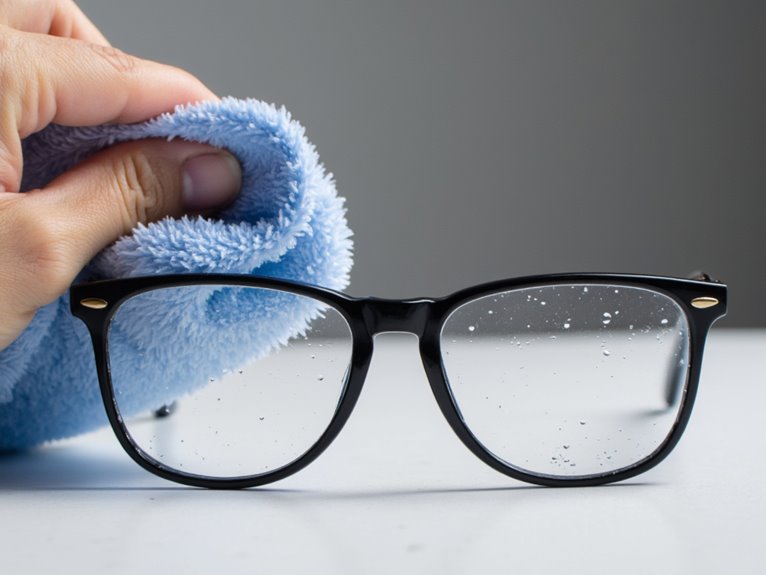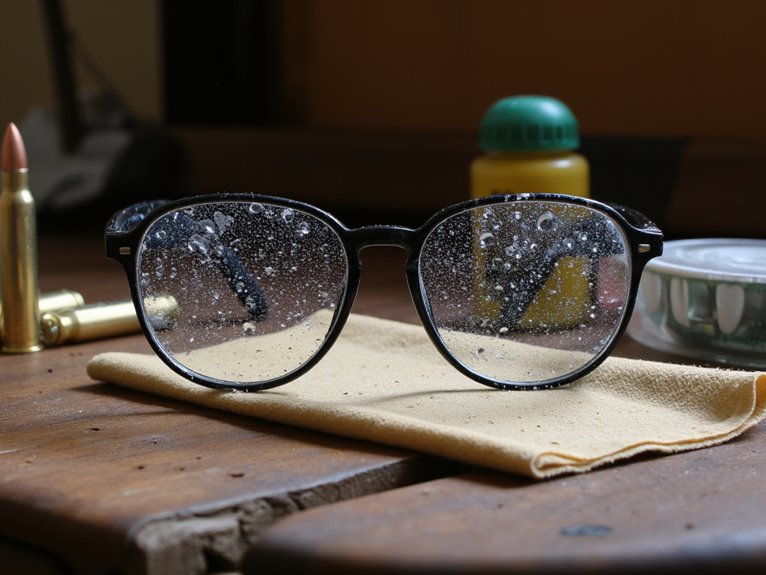How to Prevent Fogging in Your Shooting Glasses
You can prevent fogging in your shooting glasses by choosing factory-applied anti-fog coatings, which are more durable than DIY solutions. Apply anti-fog sprays, wipes, or gels according to manufacturer instructions for temporary protection. Confirm proper frame fit with adjustable nose pads to minimize air gaps while maintaining ventilation. Position glasses to overlap mask edges and redirect exhaled breath away from lenses. Clean lenses with microfiber cloths and allow air-drying to preserve protective coatings. Advanced techniques and environmental management strategies offer additional solutions.
We are supported by our audience. When you purchase through links on our site, we may earn an affiliate commission, at no extra cost for you. Learn more. Last update on 27th December 2025 / Images from Amazon Product Advertising API.
Notable Insights
- Apply anti-fog coatings or solutions (sprays, wipes, creams) to lenses following manufacturer instructions for optimal clarity.
- Ensure proper frame fit with adjustable nose pads and correct temple positioning to minimize air gaps.
- Position masks with snug nose seals and overlap glasses on top edge to redirect breath away.
- Allow lenses to air dry naturally after applying treatments and avoid wiping to preserve protective layers.
- Use accessories like breath deflectors, clip-on vents, and moisture-wicking headbands to manage airflow and sweat.
Choose Anti-Fog Coated Shooting Glasses for Maximum Protection
When selecting shooting glasses, anti-fog coated lenses represent the most reliable solution for preventing vision obstruction during critical moments.
These coatings chemically modify lens surfaces to reduce surface tension, enabling water vapor to spread evenly rather than beading up into vision-blocking droplets.
Anti-fog coatings chemically alter lens surfaces, allowing water vapor to spread uniformly instead of forming vision-obstructing droplets.
Factory-applied anti-fog treatments offer superior lens durability compared to DIY sprays or wipes.
Professional application guarantees even coverage across the entire lens surface, maintaining effectiveness through repeated cleaning cycles and environmental exposure.
Modern anti-fog coatings integrate seamlessly with other protective features like UV blocking and anti-scratch properties.
Most manufacturers now offer anti-fog as standard or optional upgrades on shooting glasses that meet ANSI safety standards.
This combination provides thorough eye protection while maintaining clear vision during humid conditions or temperature changes that typically cause fogging. Clear vision enables faster decision-making speed when identifying targets and assessing shooting environments.
Removing glasses to wipe away fog interrupts tasks and increases the risk of accidents during shooting activities.
Quality anti-fog coatings provide the same peace of mind that firearm owners seek when investing in reliable protective equipment for their shooting activities.
Apply Anti-Fog Solutions and Treatments to Your Lenses
Three primary categories of anti-fog solutions can transform your shooting glasses from fog-prone liabilities into reliable optical tools.
Anti fog sprays deliver quick application by coating clean, dry lenses with a protective layer that air-dries without wiping.
Anti fog wipes provide portable convenience, requiring you to rub both lens surfaces and allow complete air-drying for ideal protection.
Creams and gels offer extended durability, lasting hours to days when properly buffed onto lens surfaces.
Clean your lenses thoroughly before applying any treatment to guarantee proper adhesion. Apply solutions evenly across both sides for thorough coverage.
Never wipe lenses after spray or wipe application—this removes the protective coating.
Follow product-specific instructions carefully, as some require buffing while others need undisturbed air-drying for maximum effectiveness. These coatings work by reducing surface tension of water droplets on your lenses, preventing condensation from forming visible fog. Advanced anti-fog technology from reputable manufacturers ensures consistent performance across diverse shooting environments.
Optimize Ventilation and Proper Fit to Minimize Moisture Buildup
Beyond surface treatments, your shooting glasses’ ventilation system and fit directly control moisture accumulation around your lenses.
Proper airflow management through built-in vents, combined with an optimized seal against your face, creates the foundation for fog-free performance.
You’ll also need to coordinate your protective gear positioning to work with these ventilation features rather than against them.
When wearing electronic hearing protection, ensure the headband and ear cup positioning doesn’t interfere with your glasses’ ventilation channels or create additional pressure points that could compromise the seal.
Built-in Ventilation Features
Built-in ventilation systems transform ordinary shooting glasses into fog-resistant equipment by engineering controlled airflow around your lenses. These advanced ventilation systems incorporate multiple design elements that work together seamlessly.
Scoop ventilation increases airflow around frames while maintaining impact resistance features required for shooting sports.
Rubber ventilation bars positioned between lens and forehead create essential air circulation pathways. These bars allow heat to escape while preventing moisture accumulation near your eyes. They also keep lenses away from skin contact, reducing smudging during extended use.
Side vents and endpiece cutouts facilitate continuous moisture expulsion. These openings support air exchange without compromising UV protection or safety compliance.
Adjustable ventilation features let you customize airflow based on environmental conditions, ensuring peak performance across different shooting scenarios.
Proper Glasses Fit
While built-in ventilation features create airflow pathways, achieving the right frame fit determines whether those systems can function effectively against fogging. Proper frame adjustment begins with selecting glasses featuring adjustable nose pads and temple arms that customize your fit while reducing gaps where warm air enters.
Nose pad optimization requires soft silicone pads that contour closely to your nose bridge, minimizing upward air leakage while maintaining small ventilation channels.
Position temple arms to rest comfortably without sliding, preventing frequent repositioning that exposes lenses to breath moisture.
Balance snug contact with adequate airflow—frames shouldn’t sit flush against your face, which traps warm air.
Lightweight materials reduce perspiration accumulation, while proper spacing allows heat dissipation without disturbing your sight picture during shooting activities.
Mask Positioning Techniques
Where does most fogging originate when you’re wearing both a mask and shooting glasses?
The top edge of your mask releases warm breath that condenses on cooler lenses. Achieving proper mask seal prevents this upward airflow. Fit the mask snugly over your nose using the built-in nose wire to mold the shape. Apply medical tape along the upper edge for additional sealing.
Position your glasses so the frame bottom overlaps the mask’s top edge. This creates a physical barrier directing breath away from lenses. Maintain 14-20mm lens-to-eye distance for air circulation.
Control breath direction by breathing through your nose rather than mouth, sending warm air downward instead of upward. Avoid pressing glasses too firmly against the mask, which traps moisture and increases fogging potential.
Use Effective Cleaning Techniques to Create Fog-Resistant Surfaces

You can create fog-resistant surfaces using simple household cleaning techniques that work as effectively as commercial products.
The dish soap method involves applying a small drop of glycerin-containing dish soap to clean lenses, which forms a thin protective film that prevents moisture condensation.
Proper drying techniques guarantee this barrier functions effectively while maintaining clear visibility during shooting activities.
Dish Soap Method
How can a simple household item create an effective anti-fog barrier on your shooting glasses?
Dish soap effectiveness stems from its glycerin content, which forms a transparent protective film that reduces moisture condensation. This makes it one of the most accessible fog prevention methods available.
Apply a tiny drop to each lens and rub evenly across the entire surface.
Rinse lightly with water, then air-dry or wipe gently with a microfiber cloth.
For spray applications, mix 1/4 cup water, 1/4 cup rubbing alcohol, and one drop of dish soap.
The treatment is short-lived, requiring reapplication after exposure to warm air several times.
While cost-effective and readily available, this method offers temporary protection compared to commercial anti-fog products.
Proper Drying Techniques
Three fundamental drying principles determine whether your shooting glasses maintain their fog-resistant properties after cleaning.
First, allow lenses to air dry naturally to preserve protective anti-fog coatings. Never wipe wet lenses immediately with dry cloths, as this removes essential protective layers.
After air drying completes, use clean microfiber cloths to gently buff away residual moisture. Paper towels and tissues scratch lens surfaces and compromise fog resistance. Your drying methods directly impact coating longevity.
Ensure complete moisture removal before lens storage to prevent fog-inducing condensation buildup. Store glasses in protective cases only after thorough drying.
Rushed drying damages specialized coatings that manufacturers engineer to resist fogging. Proper technique takes patience but preserves your investment in quality shooting eyewear.
Manage Environmental Factors and Shooting Behaviors
Environmental conditions play a decisive role in fogging prevention, with temperature differentials, humidity levels, and airflow patterns creating the primary conditions that cause condensation on shooting glasses.
Rapid shifts between outdoor cold and indoor warmth create immediate fogging through condensation physics. Maintain stable environmental temperature by avoiding abrupt climate changes and using shelter from direct sunlight.
Effective humidity control requires monitoring moisture levels and positioning yourself in drier microclimates when possible. High humidity increases condensation rates exponentially.
Manage physical exertion to reduce sweat-induced moisture near your lenses. Use moisture-wicking headbands and maintain airflow around your eyewear through proper ventilation.
When wearing masks, secure nose clips tightly and position glasses slightly forward to prevent warm breath from reaching lens surfaces.
Adjust Frame Fit and Use Accessories for Better Fog Prevention
While environmental control addresses external fogging factors, proper frame adjustment and strategic accessories create the most immediate impact on lens clarity during shooting activities.
Frame adjustments targeting nose pad positioning and temple arm pressure directly influence airflow patterns around your lenses. Loosening overly tight frames increases ventilation by 15-20%, reducing moisture buildup that causes fogging.
Proper nose pad and temple adjustment creates optimal airflow, boosting ventilation up to 20% for clearer lenses.
Essential airflow improvements include:
- Adjustable nose pads customized to your facial structure for ideal ventilation gaps
- Temple arms positioned to prevent excessive sealing while maintaining secure fit
- Foam-lined inserts that filter dust while preserving breathable barriers
- Anti-fog breath deflectors that redirect exhaled moisture away from lens surfaces
External clip-on vents enhance circulation without compromising eye protection.
Proper sizing according to face shape eliminates gaps that trap warm air, while moisture-wicking headbands prevent sweat from reaching lenses. When shooting from covered positions or under desk setups, consider how ventilation patterns affect both your glasses and nearby equipment storage.
On a final note
You’ve got multiple strategies to prevent fogging in your shooting glasses. Start with anti-fog coated lenses and supplemental treatments. Confirm proper ventilation through correct frame fit and positioning. Clean lenses with appropriate solutions to maintain fog-resistant surfaces. Control environmental factors like temperature differential and humidity when possible. Adjust your shooting position and breathing patterns to minimize moisture buildup. These combined approaches will keep your vision clear during critical moments.

